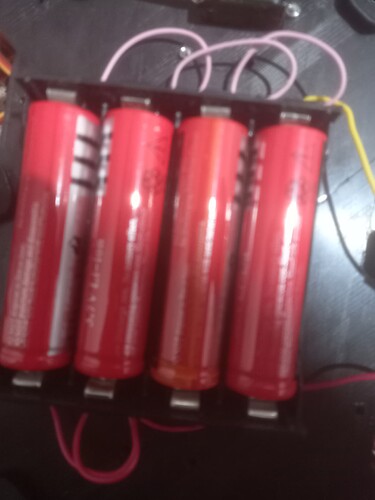Hello. I want to power ESP8266 with 3.7 V and 35 A battery. How can I do this?
This is the battery:
Ok, so I can just about make out that these are 3.7V Li-on cells. They are all facing the same way so we can perhaps guess they are connected in parallel. You have not provided an explanation of why it needs 35A of current but I would be surprised if 4 or even 8 of those AA cells would supply that.
A suitable 3V3 LDO might just have enough headroom (low enough dropout voltage) to regulate 3.7V down to 3.3V for the ESP8266, but if you are intending on driving heavy loads such as servos or motors there might be other considerations.
It would help to get a fuller picture of what you are trying to accomp;lish. Could you provide a little more explanation and perhaps a diagram of your intended setup?
Connect the battery to V-in (5volt pin).
If that works depends on which ESP8266 board you have.
Some have a 3.3volt regulator with 0.1volt dropout, other (most) boards don't.
You have a good chance if the regulator is tiny, and has 5 pins.
The ESP8266 is obsolete, and should be replaced with a (single-core) ESP32.
The Seed XIAO ESP32C3 is a good replacement.
It comes with LiPo battery connection and built-in charger.
Leo..
Try using a SEPIC converter. It will maintain a stable output voltage as the batteries transition from fully charged to exhausted.
I want to control 18 MG995 servomotors. I connected the cells in parallel. I need over 30 A to control these servos. and now I don't know how to power ESP8266 with it?
positive to VIN and negative to ground?
which model do you offer?
Then you must spot-weld the cells.
The wires you have now between the batteries can't carry more than the current for one servo. 30A wire is about the thickness of a pencil.
Leo..
Never put batteries in parallel!
Share them in groups, for example 3-4 servos per one 18650 cell. So you don't need parallel batteries. But you still need to boost the voltage.
2S lifepo4 battery pack would be ideal choice, you can power the whole setup from one battery pack without up/down converters.
Seconded !!
You need to review you power supply , those wires can’t supply that current .
Sorry, I don’t sell or represent any of them. You can do some research online to find options that fit your needs. If it’s for powering an Arduino, they’re generally not that expensive. However, for something like 30 amps, I would expect them to be more costly.
why?
but it is over 6 V while my power supply must be between 3.3 V and 5.5 V. And I can't share them in groups because I use PCA9685 for controlling servos and It is connected to one power supply.
But they are working with PCA9685 successfully now
Thanks
One battery can discharge into another resulting high currents between batteries. Not only does it waste battery energy but it is also dangerous as the high currents can result in battery explosion or fire, especially with high current Li-ion batteries.
That board is controlling servo signal(pwm).And Vcc is max 5.5V. You can use V+/GND to pass the power to servo as well, or you can power them directly from power supply/supplies(common gnd needed of course). V+ voltage can be higher than 5.5V, it's not connected to the chip anyhow.
You seem to think that the PCA9685 is powered from the servo supply.
The PCA9685 is (should be) powered from the 3.3volt pin of the ESP.
Servo power (screw terminal) is a separate circuit, with only grounds shared.
The screw terminal is only connected to the supply pins of the servo, nothing else.
Leo..
Thanks for guidance
